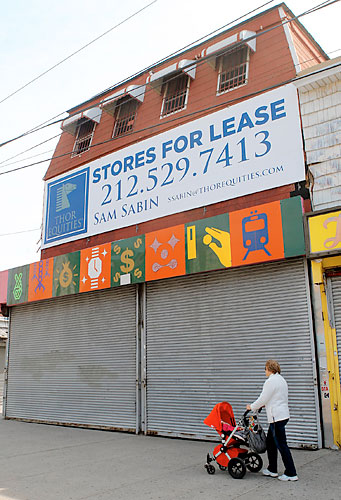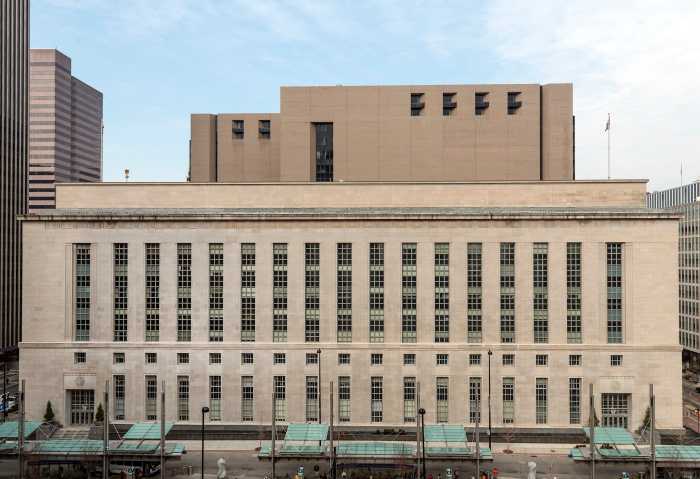The developer who ordered the demolition of Coney Island’s oldest remaining building should have committed to keeping the structure standing, according to distraught Coney Islanders, who charged that Joe Sitt — the founder of real-estate firm Thor Equities — employed a strategy of ‘demolition by neglect’ in order to justify tearing down the Grashorn Building.
“It should’ve been saved — he should’ve restored it. It’s a beautiful building,” said Community Board 13 member Orlando Mendez. “It was completely neglected, it was kept vacant, it was in disrepair — they didn’t do any kind of maintenance on that building to keep it in good shape.”
Demolition on the rear of the more than 130-year-old building — which is located on Surf Avenue between Jones Walk and W. 12th Street — began weeks ago, according to Mendez. The Department of Buildings in January approved a demolition application that a rep for beleaguered local demolition company Breeze National — which the New York Daily News in 2013 reported had a deadly safety record, and for years was run by an alleged mobster — filed to tear it down.
Sitt scooped up the property for $1.4 million in 2005, and the building has sat vacant since then, according to local historian Charlie Denson, who first reported news of the demolition in March, on the Coney Island History Project blog.
But the building has a storied history, and was buzzing with activity for most of its lifespan: entrepreneur Henry Grashorn first erected the three-story structure in the late 1880s, opening a hardware store on the ground floor where amusement-park operators purchased tools to make repairs on their nearby rides, according to Denson, who said Grashorn also operated the top two floors as a hotel.
And in 1903, the establishment survived a devastating fire that incinerated many of the surrounding buildings, making its endurance all the more remarkable, Denson said.
“Everything on both sides of it burned, so the fact that this survived is pretty amazing,” he said.
In 1971, amusement operator Wally Roberts purchased the property, refashioning the ground floor into an arcade, and using the top two floors as an apartment and a workshop, according to Denson. The historian added that the building was in pristine condition when Sitt bought it more than a decade ago, and claimed that the developer chose to neglect the structure and let it fall into a state of disrepair since then.
“When they bought the building from Wally Roberts, it was in perfectly good condition,” Denson said. “But he has not maintained the property; he just let it deteriorate. There were squatters in there, there was garbage, he didn’t shovel the snow, didn’t clean up…it seems almost intentional.”
Reps for Thor Equities did not respond to repeated inquiries about locals’ allegations of demolition by neglect, why Sitt decided to demolish the building, what he plans to do with the property and whether or not he regularly maintained it, if he ever sought landmark status for it, or ever considered restoring it to full or partial use.
Sitt was the neighborhood’s largest landowner until he sold a large portfolio of his Coney Island holdings to the city’s Economic Development Corporation for $95.6 million in 2009, when the Council passed the neighborhood’s sweeping rezoning, according to a Real Deal report.
Shortly thereafter, the real estate honcho demolished three other historic, century-old neighborhood structures that he owned, which local preservationists tried to save to no avail: the Bank of Coney Island, at W. 12th Street and Surf Avenue; Henderson’s Music Hall — where comedian Harpo Marx made his debut — at Surf and Stillwell avenues; and the Shore Hotel, at Henderson Walk and Surf Avenue. The developer installed candy emporium It’s Sugar at the site of the music hall, and the other two lots sit empty.
Last fall, Sitt attempted to shed even more of his local land when he put 21 of his remaining area properties — which allegedly occupy nearly 12 football fields’ worth of space — up for sale, the Real Deal reported at the time.
The district manager of Community Board 13 said the latest demolition amounted to a tragedy, and that Sitt failed to adequately maintain the property during the time that he owned it.
“It’s a shame that it’s going to be demolished,” said Eddie Mark. “If you don’t put money in it, it’s not going to improve by itself. It’s a shame that it’s gone to that level of disuse.”
Denson added that razing would enshrine Sitt as an unsavory character in the neighborhood’s history.
“If he really cared about Coney Island, he could have restored the building — he could’ve been a hero instead of a villain,” he said.

























